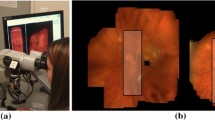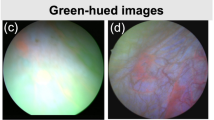Abstract
Background
Images produced by rod-lens telescopes used in minimally invasive surgery are brightest in the central region and darker at the periphery. To enable a clear view of the darker regions of the image, the intensity of light from the source usually is set to a high level. This often causes substantial reflection and glare from surgical tools and some tissue surfaces, which can be disturbing for the surgeon. This study investigated digital image processing methods in an attempt to reduce glare without introducing other adverse qualities into the images.
Methods
Two methods of reducing glare in local high-brightness regions of the image were evaluated. The first method reduced intensity by a fixed amount while also optionally introducing a slight color. The second method combined a proportion of the original intensity value with a proportion of a lower intensity value, again with an optional color bias. Two surgical video clips were modified with each of 13 different glare-reduction variants using these methods. These and the original sequence were played to a group of 10 experienced surgeons for subjective assessment.
Results
The pixel-based methods both showed statistically significant improvements over the original version. The incorporation of a slight yellow bias was preferred to a straightforward gray-level reduction. The simple approach of using a lower level of brightness alone was found to be unacceptable. Both new methods work in real time at normal video speeds.
Conclusions
Antiglare methods have been found that reduce the perception of glare and are otherwise unobtrusive. This encourages further work to refine the preferred methods and to test them with a larger group over a wider range of video sequences. Clinical trials then will follow.








Similar content being viewed by others
References
Park S-W, Hong K-S (2001) Practical ways to calculate camera lens distortion for real-time camera calibration. Pattern Recogn 34:1199–1206
Smith W, Vakil N, Maislin S (1992) Correction of distortion in endoscope images. IEEE Trans Med Imaging 11:229–238
Asari K, Kumar S, Radhakrishnan D (1999) A new approach for nonlinear distortion correction in endoscopic images based on least squares estimation. IEEE Trans Med Imaging 18:345–354
Gregor K, Matej K, Rihard K (2004) Wide-angle camera distortions and nonuniform illumination in mobile robot tracking. Robot Auton Syst 6:125–133
Leong F, Brady M, McGee J (2003) Correction of uneven illumination (vignetting) in digital microscopy images. IEEE Trans Pattern Anal Mach Intell 23:643–660
Jambhorkar SS, Gornale SS, Humbe VT, Manza RR, Kale KV (2006) Uneven background extraction and segmentation of good-, normal-, and bad-quality fingerprint images. In: Proceedings of the international conference on advanced computing and communications, 20–23 December, IEEE Mangalore India, vol 34, pp 222–225
Shi Z-X, Venu G (2004) Historical document image enhancement using background light intensity normalization. In: Proceedings of the 17th international conference on pattern recognition, Cambridge, UK, vol 1, pp 473–476
Arnold M, Ghosh A, Ameling S, Lacey G (2010) Automatic segmentation and inpainting of specular highlights for endoscopic imaging. EURASIP J Image Video Process, article ID 814319. doi:10.1155/2010/814319
Tan P, Lin S, Quan L, Shum H-Y (2003) Highlight removal by illumination-constrained inpainting. In: Proceedings of the 9th IEEE international conference on comput vision, Nice, France, vol 1, pp 164–169
Stoyanov D, Guang Z-Y, Yang (2005) Removing specular reflection components for robotic-assisted laparoscopic surgery. In: Proceedings of the IEEE international conference on image processing, Genoa, Italy, vol 3, pp 632–635
Lange H (2005) Automatic glare removal in reflectance imagery of the uterine cervix. Proc SPIE Med Imaging 5747:2183–2192
Vogt F, Paulus D, Heigl B, Vogelgsang C, Niemann H, Greiner G, Schick C (2002) Making the invisible visible: highlight substitution by color light fields. In: Proceedings of the 1st European conference on colour in graphics, imaging, and vision (CGIV ’02), Poitiers, France, pp 352–357
Vogt F, Krüger S, Schmidt J, Paulus D, Niemann H, Hohenberger W, Schick CH (2004) Light fields for minimal invasive surgery using an endoscope positioning robot. Methods Inf Med 43:403–408
International Telecommunication Union (1994) Recommendation BT.601-4 (07/94): encoding parameters of digital television for studios. ITU, Geneva
Brindley S (1953) The effects on colour vision of adaptation to very bright lights. J Physiol 122:332–350
Cavanagh P, Anstis M, Macleod A (1987) Equiluminance: spatial and temporal factors and the contribution of blue-sensitive cones. J Opt Soc Am A 4:1428–1438
Wang W, Xia T, Li L, Tan CL (2001) Matching of double-sided document images to remove interference. In: 7th International conference on computer vision and pattern recognition, Hawaii, vol 1, pp. 540–551
Adini Y, Moses Y (1997) The problem of compensating for changes in illumination direction. IEEE Trans Pattern Anal Mach Intell 19:721–732
Disclosures
Eric Abel, Wei Xi, and Paul White have no conflicts of interest or financial ties to disclose.
Author information
Authors and Affiliations
Corresponding author
Rights and permissions
About this article
Cite this article
Abel, E., Xi, W. & White, P. Methods for removing glare in digital endoscope images. Surg Endosc 25, 3898–3905 (2011). https://doi.org/10.1007/s00464-011-1817-8
Received:
Accepted:
Published:
Issue Date:
DOI: https://doi.org/10.1007/s00464-011-1817-8




